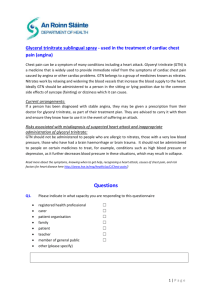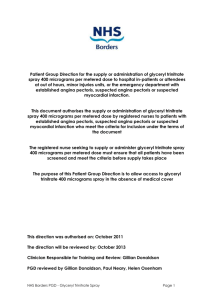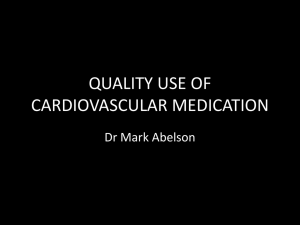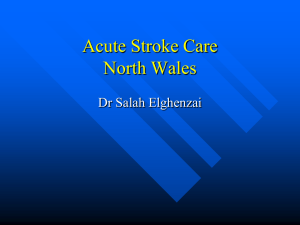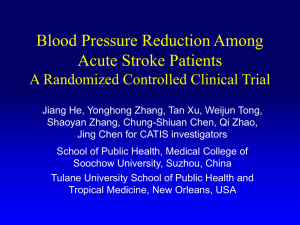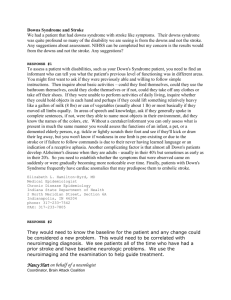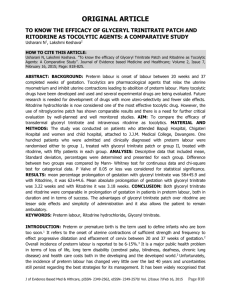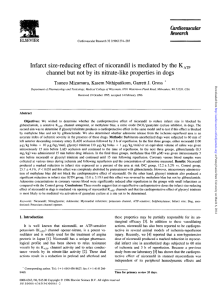DOCX ENG
advertisement
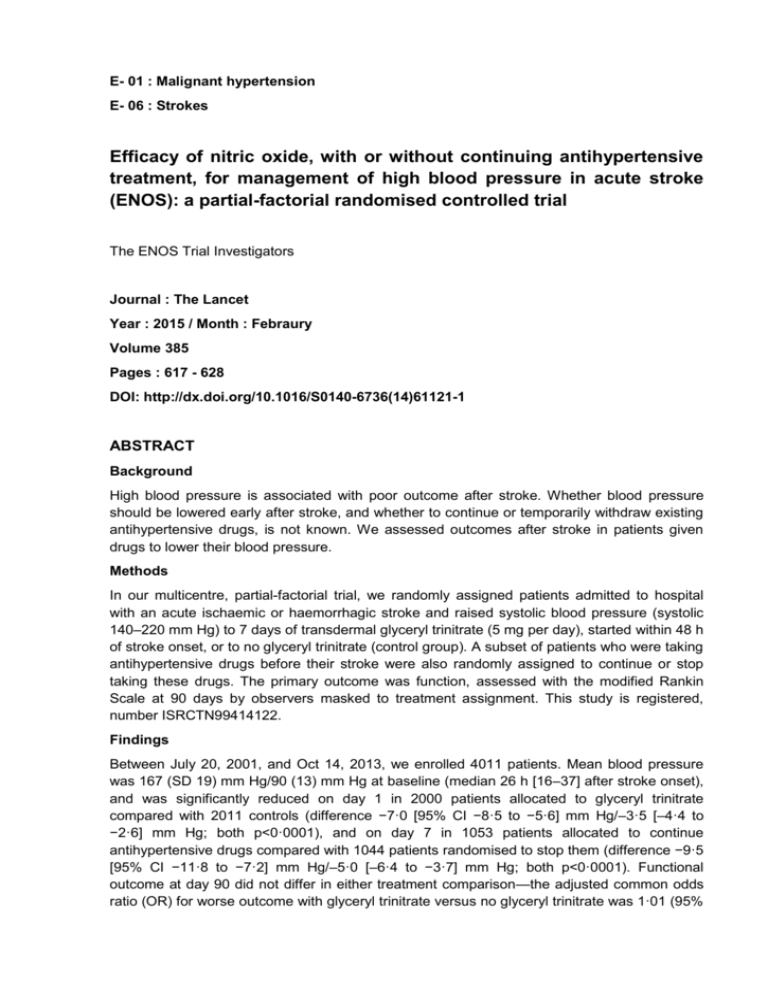
E- 01 : Malignant hypertension E- 06 : Strokes Efficacy of nitric oxide, with or without continuing antihypertensive treatment, for management of high blood pressure in acute stroke (ENOS): a partial-factorial randomised controlled trial The ENOS Trial Investigators Journal : The Lancet Year : 2015 / Month : Febraury Volume 385 Pages : 617 - 628 DOI: http://dx.doi.org/10.1016/S0140-6736(14)61121-1 ABSTRACT Background High blood pressure is associated with poor outcome after stroke. Whether blood pressure should be lowered early after stroke, and whether to continue or temporarily withdraw existing antihypertensive drugs, is not known. We assessed outcomes after stroke in patients given drugs to lower their blood pressure. Methods In our multicentre, partial-factorial trial, we randomly assigned patients admitted to hospital with an acute ischaemic or haemorrhagic stroke and raised systolic blood pressure (systolic 140–220 mm Hg) to 7 days of transdermal glyceryl trinitrate (5 mg per day), started within 48 h of stroke onset, or to no glyceryl trinitrate (control group). A subset of patients who were taking antihypertensive drugs before their stroke were also randomly assigned to continue or stop taking these drugs. The primary outcome was function, assessed with the modified Rankin Scale at 90 days by observers masked to treatment assignment. This study is registered, number ISRCTN99414122. Findings Between July 20, 2001, and Oct 14, 2013, we enrolled 4011 patients. Mean blood pressure was 167 (SD 19) mm Hg/90 (13) mm Hg at baseline (median 26 h [16–37] after stroke onset), and was significantly reduced on day 1 in 2000 patients allocated to glyceryl trinitrate compared with 2011 controls (difference −7·0 [95% CI −8·5 to −5·6] mm Hg/–3·5 [–4·4 to −2·6] mm Hg; both p<0·0001), and on day 7 in 1053 patients allocated to continue antihypertensive drugs compared with 1044 patients randomised to stop them (difference −9·5 [95% CI −11·8 to −7·2] mm Hg/–5·0 [–6·4 to −3·7] mm Hg; both p<0·0001). Functional outcome at day 90 did not differ in either treatment comparison—the adjusted common odds ratio (OR) for worse outcome with glyceryl trinitrate versus no glyceryl trinitrate was 1·01 (95% CI 0·91–1·13; p=0·83), and with continue versus stop antihypertensive drugs OR was 1·05 (0·90–1·22; p=0·55). Interpretation In patients with acute stroke and high blood pressure, transdermal glyceryl trinitrate lowered blood pressure and had acceptable safety but did not improve functional outcome. We show no evidence to support continuing prestroke antihypertensive drugs in patients in the first few days after acute stroke. Funding UK Medical Research Council. COMMENTS High blood pressure is an usual finding present in patients with acute ischaemic stroke or haemorrhagic stroke. Affected patients have a worse outcome, Lowering of blood pressure acutely after stroke might therefore reduce these events and improve functional outcome, providing that cerebral perfusion is not reduced in the presence of dysfunctional cerebral autoregulation. Several large trials have tested the safety and efficacy of individual drugs or management strategies that lower blood pressure, with use of meta-regression, a U-shaped relation was shown between outcome and difference in blood pressure between treatment groups in previous trials, with both large reductions or any increase in blood pressure associated with a worse functional outcome. Nitric oxide donors are candidate treatments for acute stroke because of several effects—nitric oxide is a cerebral and systemic vasodilator that lowers blood pressure, modulates vascular and neuronal function, is neuroprotective, and inhibits apoptosis Treatment of hypertension effectively prevents first and recurrent stroke. Duration of antihypertensive treatment is not well defined. Continuing antihypertensive drugs might help to reduce early recurrence and haematoma expansion, and improve functional outcome after stroke. Alternatively, stopping treatment temporarily might be advantageous for several reasons : First, some antihypertensive drugs might be hazardous when started in acute stroke. Second, many patients do not take their blood pressure drugs regularly, and so correct administration of these drugs in hospital can lead to large and potentially harmful falls in blood pressure. Third, antihypertensive drugs can cause substantial hypotension in the presence of hypovolaemia and dehydration, which are commonly present in patients with acute stroke who might not be taking fluids appropriately. Fourth, stopping of treatment might increase perfusion through collateral vessels and optimise salvage of penumbral tissue. Fifth, blood pressure-lowering drugs might worsen cerebral perfusion in the presence of severe ipsilateral carotid artery stenosis. Sixth, drugs taken orally could lead to aspiration and pneumonia in the presence of dysphagia. Here are reported the findings of the Efficacy of Nitric Oxide in Stroke (ENOS) partial-factorial randomised controlled trial and the assessment of the safety and efficacy of glyceryl trinitrate given within 48 h to patients with acute ischaemic or haemorrhagic stroke and high blood pressure. Treatment was started immediately after randomisation, was given daily for 7 days, and consisted of a glyceryl trinitrate dermal patch (5 mg) or no patch. Glyceryl trinitrate patches were sourced locally. The dose of glyceryl trinitrate was not adjusted during treatment, and patches were left on for 24 h, such that there was no overnight glyceryl-trinitrate-free period. In patients randomly assigned to continue antihypertensive drugs, the same drugs and doses were started at the next normal time when due, and were given for 7 days. After the first dose, systolic and diastolic blood pressure were lower in the glyceryl trinitrate group by 7·0 (95% CI 5·6–8·5) mm Hg/3·5 (2·6–4·4) mm Hg (two-sided p<0·0001/p<0·0001) than in those given no glyceryl trinitrate. The difference in blood pressure between the glyceryl trinitrate and no glyceryl trinitrate groups then diminished and did not differ statistically after day 3 When adjusted for stratification and minimisation variables, the distribution of functional activity (mRS) between the glyceryl trinitrate group (1993 patients assessed; >99%) and the no glyceryl trinitrate group (2002 patients assessed; >99%) did not differ The cumulative risk of all-cause death (mRS 6) during follow-up did not differ between the group given glyceryl trinitrate and the group not given glyceryl trinitrate There was no effect on functional outcome with either glyceryl trinitrate (compared with no glyceryl trinitrate) or of continuing prestroke antihypertensive drugs compared with stopping them temporarily when started within 48 h of stroke onset. The neutral results for glyceryl trinitrate were present across many functional outcome measures at day 90 including dependency, activities of daily living, cognition, mood, and quality of life. In conclusion, the authors noted no benefit for lowering of blood pressure with glyceryl trinitrate in patients with acute stroke and raised blood pressure. The results are compatible with a neutral meta-analysis of previous trials of several strategies to lower blood pressure in patients with acute ischaemic, haemorrhagic, or mixed stroke. Pr. Jacques CHANARD Professor of Nephrology
